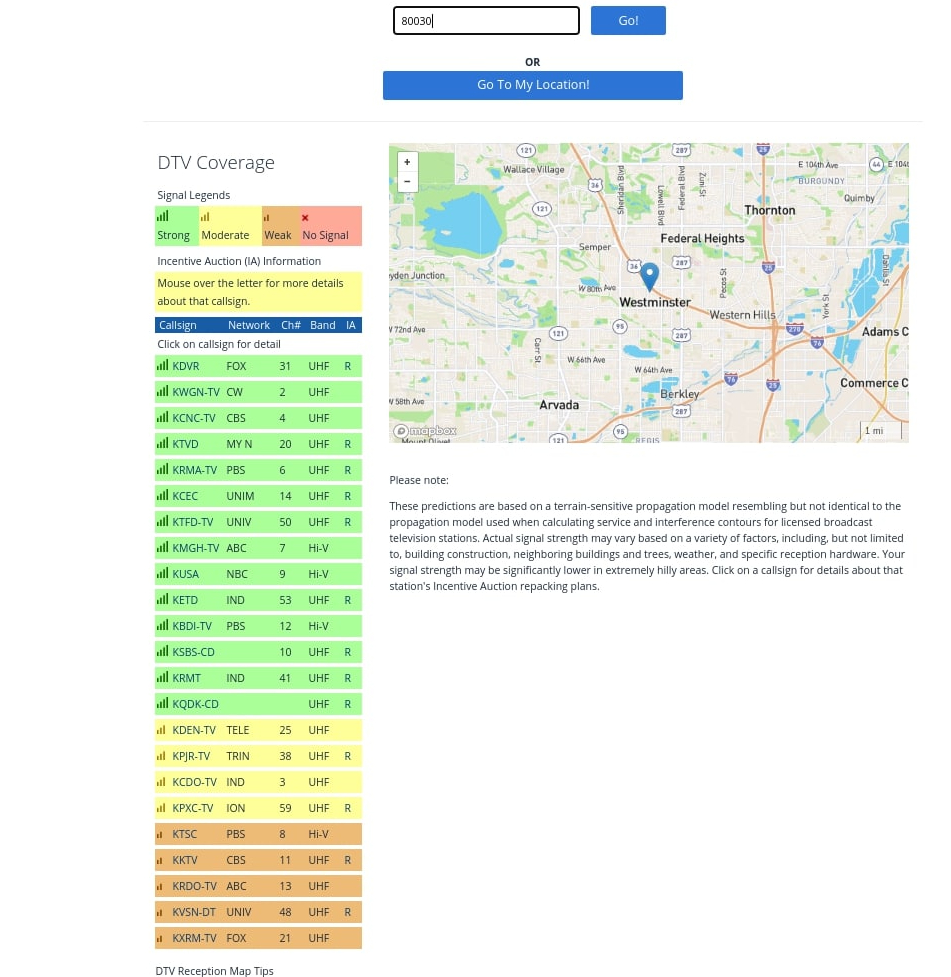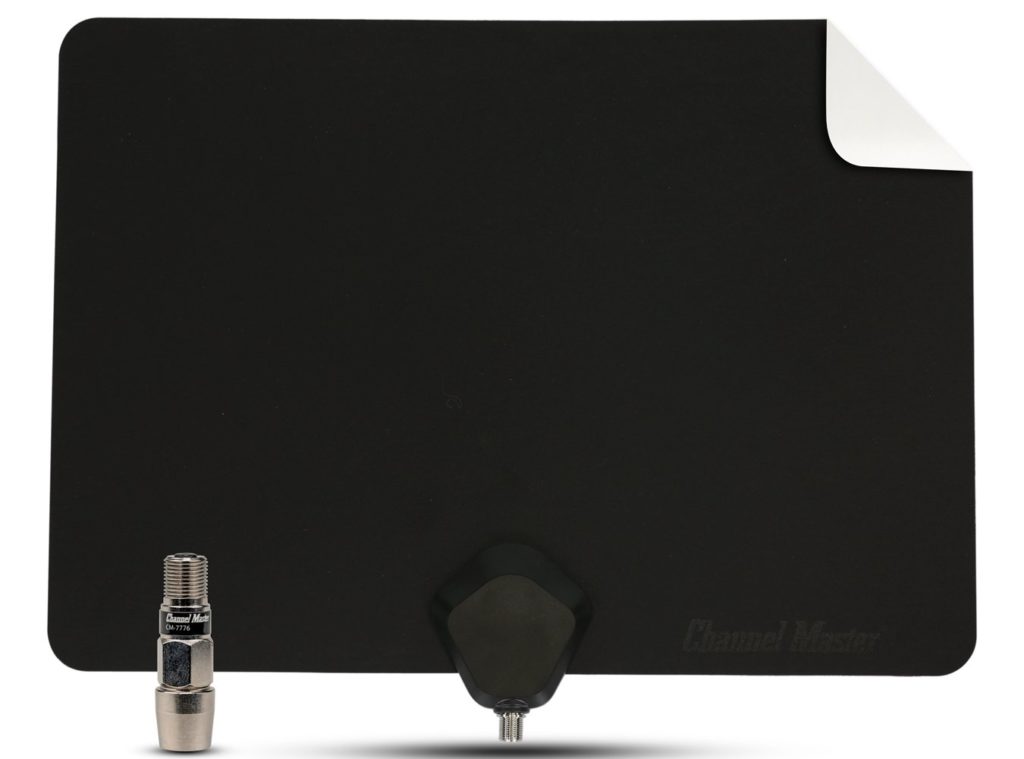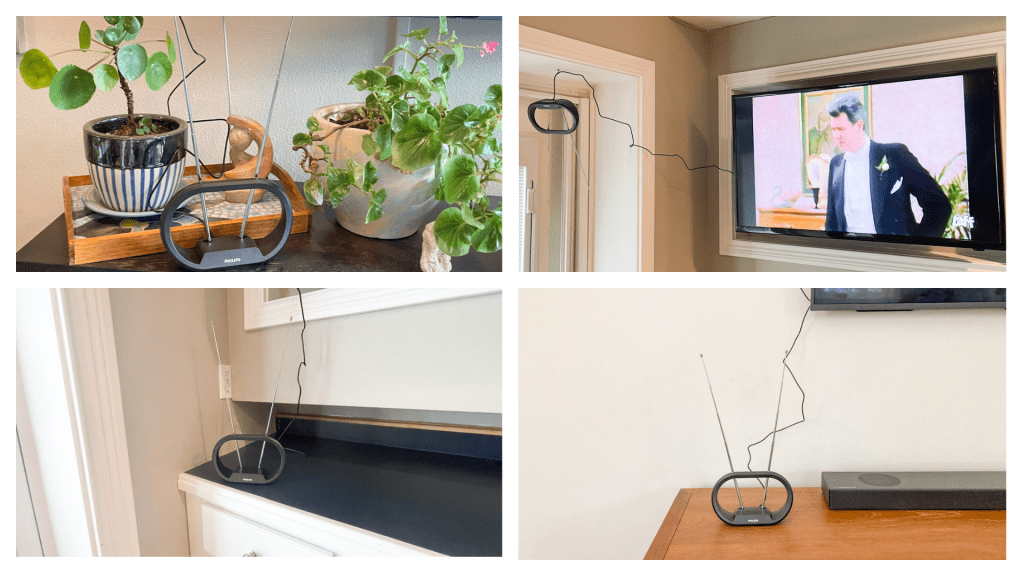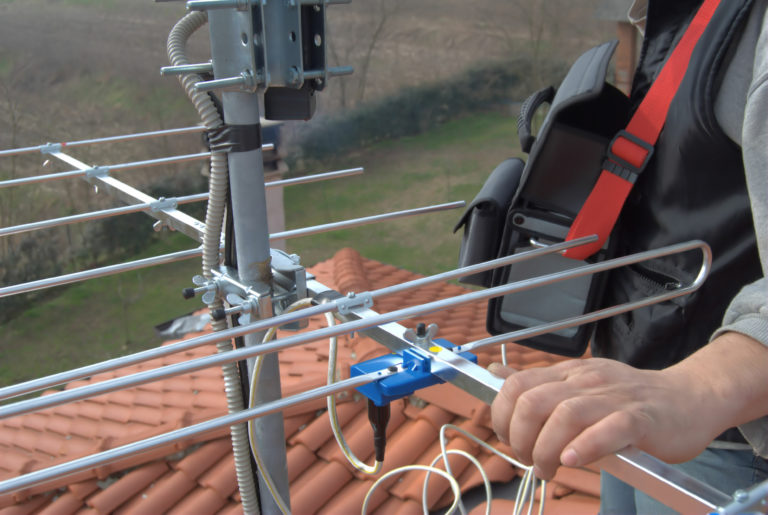Watching free, over-the-air TV with an antenna is simpler than you may think. In many cases, you can take an antenna out of the box, connect the cable to your TV, run a channel scan and voila! You have dozens of local channels to surf.
The number of channels you can access and how clearly they come in is based on a number of factors, including your distance from the point of broadcast, the type of antenna you have and where it’s located in your home.
Buying the right TV antenna for your home isn’t a one-size-fits-all approach. That’s why we’ve put together a step-by-step guide to what you need to know about watching free TV, including which type of antenna you may need and how to optimize its performance.
Step 1: Check how many channels you should be able to watch.
Before you begin shopping for antennas, you can get a general overview of which channels you’ll be able to pick up based on your whereabouts.
To do this, go to the Federal Communication Commission’s DTV Reception Maps. When you plug in your zip code, you’ll get a coverage menu that shows you which stations you should be able to view. Those labeled green have strong reception; yellow has moderate reception; orange has a weak reception and red is no signal.
Here’s a look at the map for my Denver suburb, which shows I should be able to pick up a lot of channels:

The FCC doesn’t make recommendations for which antenna you should use based on your location. Its reception calculations are based on an assumed outdoor antenna placed 30 feet above the ground.
There are some non-governmental sites that provide station information based on your location and antenna type. These are useful for those who aren’t interested in or able to install an outdoor antenna and would rather use a smaller indoor antenna next to their TV. I recommend you consult all of these to get a solid overview of what should be accessible to you with your antenna.
This site allows you to plug in your address or zip code and it will display a color-coded list of channels that are available in your area. The colors translate to the type of antenna you may need to access certain channels. It’s worth cross-referencing this with the others.
This site will show you how many channels you have available, plus the best channels you’ll receive. Note: Channel Master manufactures TV antennas and mounting equipment, so the products they recommend are limited to their stock. The company recommends its indoor and outdoor antennas based on your distance from broadcast towers. Looking at these maps can help you see the location of towers in relation to your home.
Antennas Direct also has a mapping tool that displays the TV transmitter in your area. You can see the distance between your home and the broadcast towers. Antennas Direct is an antenna manufacturer and recommends its products based on your location.
Step 2: Take stock of what may stand in the way of a TV signal in your home.
While these reception maps will give you a good overview of the channels you should be able to access with an antenna, the signal strength could be affected by a variety of factors — things like construction in your neighborhood, distance from a broadcast tower, the position and type of antenna, trees and weather.
Finding the best antenna can be a bit of a trial-and-error process as you discover which antenna works best in your home. Because of this, it’s a good idea to make sure you know the return policies of the stores where you’re shopping for antennas. Also, neatly open any packaging in case you need to return it.
If you are more than 20 miles from the bulk of the transmitters in your area, and you hope to watch TV in a below-ground basement, you may want to consider an outdoor antenna. But, to the point above, you could still try an indoor antenna first and then return it if it seems like it won’t work.
When you’re using an indoor TV antenna, common building materials like brick, metal siding and stucco can reduce the incoming signal.
“Any building material will impact the reliability of an over-the-air signal,” says Tyler Kleinle, who runs the “Antenna Man” channel on YouTube and previously ran an antenna installation business. “It all depends on how strong the signals are at a given location.

Since there’s less building material in the attic, setting one up there can be an alternative to placing it on the roof, he explains. However, you’ll always get the best reception and most channels with an outdoor antenna since the impact of building material is taken out of the equation, Kleinle says. In some areas, you may even get two times as many channels.
But installing a rooftop antenna can be a challenge for those who live in an apartment or who are otherwise disinclined to get on their rooftop for a DIY installation. Unless you’re well-versed in installations and comfortable working on the roof, you may want to hire a professional to mount any outdoor antennas. Keep in mind an outdoor antenna will need to connect to your TV via a cable, which means you’ll also need to determine how to run it from the roof to the location of the TV in your house.
When you’re shopping for antennas, you may see many marketed as “HD digital antennas,” but in reality, there’s no such thing as this type of antenna, explains Kleinle. Rather, TV antennas are designed for certain frequencies. So when you shop for antennas, look for ones that can get UHF and VHF frequencies so you can maximize the number of channels you pick up. You’ll need VHF to pick up channels 2 through 13, explains Kleinle.
One more thing: Don’t assume that a more costly antenna is automatically a better one. Tech experts say that your location is the biggest indicator as to whether you’ll pick up a lot of channels and a good signal. That means if a cheap antenna isn’t picking up stations, a more expensive one probably won’t either.
Step 3: Connect your antenna to your TV — and be prepared to play around with its position!
When you purchase an antenna, play around with its position and location to determine where it receives the best signal.
“An antenna should be placed near a wall or window pointed in the direction of the broadcast towers of ABC, NBC, CBS, and Fox,” Kleinle says. (This direction can be found on antennaweb.org.)
Kleinle recommends trying different locations and directions as you set up your antenna. One way to know how well-placed (or not!) your antenna is through the next step: a channel scan.
Step 4: Perform a channel scan.
Once you have your antenna connected to your TV, you need to perform a channel scan to get accurate information about the channels you can pick up.
The FCC has this handy guide that gives you instructions on how to do this, broken down by popular TV brands. But, in general, you can do this by finding the set up, settings or menu button on your remote control and then selecting the option that allows you to search for available channels.
If you ever see “weak or no signal,” “this channel is moving frequencies” or “rescan” come across your TV for a channel you once had access to, you can repeat the rescan process. You can also repeat this process every once in a while (Consumer Reports recommends doing it monthly) to make sure your TV has the current channel lineup for your area — and you should always repeat the scan after moving your antenna.

Step 5: Enjoy your free TV!
Once your antenna is connected and your channel scan is complete, start clicking through the channels. If there’s a lag in their load time or they come in glitchy, you may want to consider shifting your antenna. Make sure it’s pointed toward the station you’re trying to capture and if possible, move it closer to a window or to a higher point in your home.
While some smart TVs offer a TV guide so you can see what programming is available on all the stations in your area, this isn’t the case with all TVs. Kleinle recommends downloading a free TV guide app for your phone and scrolling that way — or there are some devices that will display a program guide on your TV for you.
Putting Top TV Antennas To The Test
To help give readers a better sense of which antenna to purchase, four Don’t Waste Your Money staffers tested seven popular antennas to find which ones worked best.
Reviewers evaluated antenna performance on things like clear pictures and how many channels were accessible. They also considered how user-friendly these antennas were, evaluating the ease of setup and the visual aesthetics of the equipment. Some had small-scale rabbit ears; others were easy-to-conceal, paper-thin antennas shaped like small placemats.
The review team tested indoor antennas, though two models had indoor/outdoor capabilities. Our testers lived varying distances from broadcast stations in Chicago, Cincinnati and Longmont, Colorado, with their homes ranging from 5 to 65 miles from broadcast towers. Housing materials also varied, with one of our testers trying out antennas in his attic in a house that has cement board siding and another ran tests in the basement of her brick house.
While Kleinle says you’re likely to see your indoor antenna performance impacted if you are more than 20 miles from a broadcast tower, one of our testers found she was able to pick up channels from over 60 miles away with an indoor antenna and another saw his indoor antenna performance impacted despite being under 10 miles from the transmitter.
Here are the pros and cons of a handful of indoor antennas our team tested.
The Best Overall Indoor Antenna: Channel Master FLATenna+ Amplified Indoor TV Antenna, $29
This flat, lightweight antenna is easy to mount on a wall or window. It features a range of up to 50 miles and a MicroAmp amplifier, which has been fine-tuned for optimal performance to improve reception. Since this antenna uses a standard RG6 coaxial cable, you can use any length you need, although it does include a 12-foot premium quality cable. It also comes with adhesive strips for mounting and an instruction guide.
Pros:
- You can choose black or white side, whichever best fits your home’s decor and style.
- Installation was fairly simple; the 3M double sided adhesive was used to put it in the window at 6-feet high.
- The inline amplifier is professional grade, by far the best one to be utilized on the indoor antennas and reception levels reflect that on the analyzer.
Cons:
- For best results, it should be placed in a window.
Best Rabbit Ear-Style Antenna: Philips Modern Loop Rabbit Ears Indoor TV Antenna, $11.39
An easy set-up and low price point made this Philips model the favorite among our testers. The antenna, which can pick up VHF and UHF signals is small and lightweight, and it’s equipped with mini rabbit ears that you could find to be either charming in a retro way or outdated.
Pros:
- With an intuitive plug-and-play set-up, our testers were able to get this antenna up and running in under five minutes and appreciated the ease of assembly.
- Under $12, the price point on this indoor antenna was the lowest among the ones tested.
- Clear picture quality and strong signal strength.
Cons:
- The cable may be too short if you want to place the antenna by the windows to maximize the number of channels you get. (One of our testers was able to pick up 42 digital channels when the antenna was on the ledge below the TV versus 64 when it was placed by the window.)
- While the antenna can stand on a TV stand or table, no mounting hardware is included should you want to hang it near a window or near your TV.
Also Consider: Winegard FL-5000 FlatWave Digital Indoor HDTV Antenna, $27.24
At first glance, this square-shaped antenna looks like an ultra-thin mouse pad. Our reviewers appreciated that it was compact and versatile; you can lie it flat next to your TV or hang it on a window or wall. A tip: If you plan to use the Command Strips this antenna comes with, be sure to identify the best place to hang the antenna first because it’s not easy to adjust the wall hangers once they adhere to a surface.
Pros:
- The set-up is quick and easy, and the package comes with a pair of Command Strips and a 15-inch long cord that can be tucked behind a TV stand.
- Weighing less than a pound, this lightweight antenna is versatile and can easily be hung on a wall or window.
- With a price point under $30, it’s less expensive than other flat antennas on the market.
- The brand offers its own website that IDs available channels in your area, helping make the setup seamless.
Cons:
- For one of our testers, the signal strength was weaker than the other antennas she tested in her basement.
Also Consider: Mohu Leaf 30 UHF/VHF Indoor TV Antenna, $35.42
A small and sleek design plus good performance made the Mohu Leaf a favorite of our reviewers. For the most part, our team got clear pictures with this paper-thin antenna, but one tester noted some glitching and pixelation issues.
Pros:
- Setup is a breeze with this small and lightweight “placemat-style” antenna. One reviewer appreciated that it could be hung with push pins or Velcro.
- While the packaging came with materials to hang it up, this antenna is versatile and could also be discreetly placed on a media console to avoid visual clutter.
- Picked up several channels and the picture was mostly clear.
- Moderate price point.
Cons:
- Some glitching and pixelation issues occurred despite changing the antenna’s position and moving it closer to a window.
Best Outdoor Antenna: Televes DiNova Boss Mix HDTV UHF/VHF Antenna, $99.95
This is one of the most popular antennas in the world. It’s smaller and more discrete than your typical antenna and can be used when within 30 miles of towers. It can be used indoors or outdoors.
Pros:
- No assembly required, only need to pull out VHF elements on each side.
- Quality materials: the product is built using materials resistant to salt air, including the metal mounting clamp.
- When testing the reception outdoors, it got optimal reception levels and picked up several more channels than the website predicted from our test location.
Cons:
- Power inserter needs to be within 3-feet of a power outlet and should be indoors, which may require a little more effort when installing.
- When tested in an attic, it received decent receive levels, but only picked up about half the channels the website predicted from our test location.
Runner-Up: Antennas Direct ClearStream 2V UHF/VHF TV Antenna, $80.56
This antenna system can be set up indoors, outdoors or placed in an attic. Not only was it the most expensive antenna our testers tried out, but the setup required more tools and time than the others. One of our testers pointed out she’s not keen on running cables into her house, which you would need to do with this and other outdoor antennas.
Pros:
- Good image quality and signal strength.
- Versatile, as it can be used indoors or outdoors. However, it would be obtrusive to have in your living room and seems to be better suited for outdoor use. One of our testers picked up 64 channels inside her home, and just a few more when it was placed outside.
Cons:
- The set-up is labor-intensive, and the assembly requires some tools, including your own Philips screwdriver, an adjustable wrench and a power drill with a 3/16 drill bit.
- The antenna system is large, especially compared to other antennas tested.
- Despite being the most expensive antenna that we tested, it didn’t come with a coaxial cable and the set-up instructions lacked detail and clarity.
Also Consider: ClearStream 1MAX UHF/VHF Indoor/Outdoor HDTV Antenna, $59.99
This antenna picked up a good deal of channels and fared well when it comes to channel strength. But our reviewers agreed that setting up this bulky antenna required too much work (and equipment), especially compared to other indoor models.
Pros:
- With options to use this antenna indoors or outdoors, our reviewers consistently picked up several channels.
- Picture quality was good and improved outdoors
Cons:
- The antenna was big and clunky if you plan to use it indoors. It could possibly work if you were able to hide it behind a TV or media console, one reviewer pointed out.
- No coaxial cable is included and you’ll need a screwdriver to set this up. This was a sticking point for our reviewers who found other products to be far more user-friendly. “I ideally want to open the box, attach the antenna to the TV, scan the channels and go,” one said.
Skip This: Insignia NS-ANT314 Indoor HDTV Antenna, $19.99
While the price point is low on this antenna, it was a flop for our review team. It didn’t pick up as many channels as other antennas. Plus, a non-detachable, short coaxial cable tethers this antenna close to the TV, a major drawback if you can get better reception and pick up more channels by placing your antenna by a window.
Pros:
- A small antenna with a minimalist design is mostly unobtrusive, despite the rabbit ears. It can stand up on your media console.
- Somewhat easy assembly, though the directions weren’t compatible with one of our reviewer’s smart TVs.
- Low price point.

Cons:
- Picture quality and glitching were a problem for our review team.
- Picked up fewer channels compared to other antennas. One reviewer noted that even some of the channels marked “yellow” on antennaweb.org — which indicates they should be accessible via a small, multi-directional antenna — were glitchy or wouldn’t load with this antenna.
- A non-removable, short coaxial cable doesn’t allow you to move this antenna very far from the TV.
Skip This: Antennas Direct ClearStream FLEX Amplified TV Antenna, 50-Mile Range, $59.99
Lack of channel strength and access was a problem for some of our reviewers, although one was able to get a broad variety of channels and a clear picture. Moving it closer to a window drastically improved the channel strength for another reviewer. The amplifier didn’t prove beneficial for our review team.
Pros:
- Easy-to-follow instructions
- Despite being larger than other flat antennas, the antenna was lightweight and easy to hang.
Cons:
- While the setup itself was easy, the extra USB cable needed for this antenna added visual clutter. The cables were black and white, and one reviewer pointed out it could have looked more streamlined if it were one color.
- Channel strength and picture quality were subpar. When compared to other antennas that were tested, one of our reviewers said this antenna, by far, picked up the fewest channels.


















